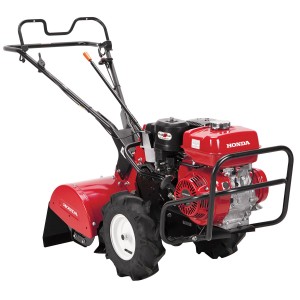 Though widely regarded as one of the most durable and dependable tiller models on the market, even Honda’s rear-tine tiller can cause operators a few headaches from time to time. Most of these headaches are caused by simple problems that can be easily diagnosed and quickly fixed. For those who aren’t sure why their engine is underperforming, or why the tines aren’t reacting as expected to common controls, consider the most common cause of these problems and the most likely fixes to bring the tiller back into normal operation.
Though widely regarded as one of the most durable and dependable tiller models on the market, even Honda’s rear-tine tiller can cause operators a few headaches from time to time. Most of these headaches are caused by simple problems that can be easily diagnosed and quickly fixed. For those who aren’t sure why their engine is underperforming, or why the tines aren’t reacting as expected to common controls, consider the most common cause of these problems and the most likely fixes to bring the tiller back into normal operation.
Safety Comes First: Tips for Tiller Owners
Troubleshooting a tiller requires the same comprehensive approach to safety as regular use or conventional maintenance. Before getting started, ensure that the tiller is away from any pets or bystanders, that debris has been cleared from the lawn, and that the engine has been allowed to cool down if the equipment was recently used. If performing work on or near the tines, use safety gloves and protective goggles to guard against cuts, scrapes, and any damage that might be caused by projectiles when getting the equipment back into working order.
A Look at the Most Common Tiller Engine Problems
Most of the headaches experienced by rear-tine tiller owners come from the equipment’s engine. From low power to a complete lack thereof, here’s what to know about the most common issues facing today’s operators and how to fix them as quickly as possible.
1. The Engine Won’t Start at All
If the tiller’s engine refuses to start, there are a number of things to check. The first, and perhaps the easiest, is to simply check the tiller’s fuel level. Any engine that lacks fuel will refuse to start, and any engine that houses only stale fuel will typically suffer from the same problems. If there is no fuel present, fill the fuel tank. If old fuel is the culprit, drain the stale gasoline and add fresh fuel to replace it.
Other common causes of a non-starting engine include spark plug fouling, a poor spark plug connection, or liquid near the spark plug. In all three cases, equipment operators should remove and check the spark plug, replacing it with a new one if any of these three problems present themselves. Otherwise, make sure the fuel valve is on, the choke is in the proper position, and the engine switch is on. If none of these fixes work, the equipment should be taken in for service at an authorized retailer.
2. The Engine Lacks Power
An engine that seems significantly underpowered typically results from bad or stale fuel, or a dirty air filter. Make sure that the tiller is not attempting to use stale fuel from a prior summer season, filling the tank with fresh fuel if needed. Remove the air filter and either clean it or replace it with an OEM Honda filter if the engine’s fuel is not to blame for low power levels. If neither of these fixes gets the tiller back in working condition, it may require service at an authorized retailer because of a clogged oil filter, fouled carburetor, or any number of other, more serious issues.
A Look at Common Tilling Problems
While most problems with the rear-tine tiller come from its engine, some homeowners have suffered from unexpected tilling problems. Typically, these problems can be solved using a few quick, at-home fixes and checking that the tiller’s settings are all properly set.
1. Tilling Quality is Exceedingly Poor
Poor tilling quality can arise due to a number of problems, whether it’s the throttle position or something like the height and angle of the drag bar. If the equipment is tilling poorly, or not tilling deep enough based on operator settings, here’s what to check:
- Throttle position: A tiller will not do its job very well if the throttle is set to a slow speed. Try moving the throttle position higher and see if the problem resolves itself.
- Excessive forward speed: Fast is good, but too fast is bad. If the tiller is showing very inconsistent results, try slowing down and see if the situation goes away.
- Drag bar problems: If the drag bar is set too high, tilling quality will suffer. Refer to the operator’s manual for tips on proper drag bar adjustment.
- Old tines: Tines that have gotten dull will simply not perform as well as a sharper, newer set. Try replacing the tines and see if tilling performance improves.
Get the Parts Needed for a Repair at HondaLawnParts.com
While some solutions to these common problems won’t require any new parts at all, other equipment issues do require replacement parts in order to bring the tiller back into full working order. When the time comes for new parts, equipment owners should visit HondaLawnParts.com. The site features an online lookup tool that filters available replacements by model or part number, or the type of engine being used. It’s the easiest way to find an exact match, and a quick fix, no matter what has gone wrong.
